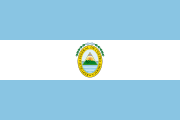Flag of Honduras
 | |
| Use | National flag, civil and state ensign |
|---|---|
| Proportion | 1:2 |
| Adopted | 7 March 1866 (modified colour on 27 January 2022) |
| Design | A horizontal triband of cyan (top and bottom) and white with five cyan five-pointed stars arranged in an X pattern centered on the white band. |
 | |
| Use | Naval ensign |
| Proportion | 1:2 |
| Design | A horizontal triband of blue (top and bottom) and white with the National Coat of Arms above an inverted arc of five blue five-pointed stars centered on the white band. |

The flag of Honduras consists of three equal horizontal stripes of cyan, white and cyan, with five cyan stars in a quincuncial pattern at the centre of the middle stripe. The two outer bands represent the Pacific Ocean and the Caribbean Sea, and also represent the blue sky and brotherhood. The inner band represents the land between the ocean and the sea, the peace and prosperity of its people, and purity of thoughts. The five stars represent the five nations of the former Federal Republic of Central America and the hope that the nations may form a union again.
In 1823, Honduras joined the United Provinces of Central America and adopted its flag. It continued using a plain blue and white triband after the union dissolved in 1838. On 7 March 1866 five blue stars were placed on the flag to represent the five original provinces: El Salvador, Costa Rica, Nicaragua, Honduras, and Guatemala.[1]
The 1949 decree specified that the stripes were to be cyan, but in practice the flag remained dark blue for the next seven decades. The Honduran government only began flying turquoise flags after the inauguration of president Xiomara Castro on 27 January 2022, after the National Autonomous University of Honduras made that recommendation in 2021.[2][3][4]
Ships of the Honduran Navy fly a naval ensign which has the coat of arms of Honduras above an inverted arch of five small stars and a pendant.
History
[edit]The origins of the Honduran flag date back to United Provinces of Central America, which Honduras was part of. It was the first country in Central America to use a blue-white-blue triband, which in turn was based on the flag of Argentina
First flag
[edit]Flag used since independence, and finally abolished in 1949. The flag has been defined as flag of the UPOCA without emblem.
Second flags
[edit]On 16 February 1866, President José María Medina modified the coat of arms and flag, adding 5 stars representing the 5 original united provinces. The most popular arrangement of blue stars was similar to the arrangement of the dots on a die, but there were also alternative arrangements. Versions other than the current one disappeared by the 1930s.
Although there wasn't any mention regarding the exact shade of blue to be used, the most common version (including the one used by military forces) used navy blue.[5]
Between 1896 and 1898 Honduras was part of a union known as Greater Republic of Central America. Within the union, Honduras still has its own flag. Around this time, an unofficial version with gold stars comes out, sometimes only considered a mistake. The likely reason for this is that the union used gold stars.[6]
Third flag
[edit]On 26 January 1949, President Juan Manuel Gálvez amended the 1866 decree, confirming the position of the stars. The decree also defined the shade of blue used on the stripes and stars as turquoise. However, that change was not implemented and the flag continued to be produced using navy blue for 73 years.[5]
Fourth flag
[edit]In 2020, the National Autonomous University of Honduras published its guidelines regarding the shades of blue used on the flag, due to the "absence" of an official position about the topic. Following the intention of the 1949 decree, the guidelines established a lighter shade of blue for the Honduran flag "until its colors are defined and regulated by legislative decree".[4]
On 4 August 2023, the Honduran Armed Forces announced a change from this month on their monograms, uniforms and logo to represent the national flag in turquoise. The announcement came shortly after President-elect Xiomara Castro also announced the use of the flag in that shade of blue.[7]
Design
[edit]Construction sheet
[edit]Colors
[edit]Colors scheme |
Blue Turquoise | White |
|---|---|---|
| RGB | 0-188-228 | 255-255-255 |
| Hexadecimal | #00bce4 | #FFFFFF |
| CMYK | 100, 18, 0, 11 | 0, 0, 0, 0 |
| Closest Pantone | 306 C[8] |
Flags of subdivisions
[edit]Departments
[edit]Ethnic group flags
[edit]| Flag | Use |
|---|---|
 |
Flag of the Garifuna |
 |
Flag of the Lenca people |
See also
[edit]- Coat of arms of Honduras
- National Anthem of Honduras
- Flag of Argentina (similar, except for the central symbolism)
References
[edit]- ^ Znamierowski, Alfred. The World Encyclopedia of Flags. Italy: Lorenz Books, 1999. 201. Print.
- ^ "Xiomara Castro: los símbolos que marcaron su histórica toma de posesión como primera presidenta de Honduras". BBC News Mundo. 21 January 2023. Retrieved 27 January 2022.
- ^ Dalma Acosta (26 January 2022). "El error histórico que no debe repetirse al implementar la Bandera azul turquesa". El Heraldo. Retrieved 13 February 2022.
- ^ a b "UNAH confirma: usará azul turquesa en Bandera Nacional". Diario Tiempo. 29 September 2020. Retrieved 25 June 2021.
- ^ a b Rodríguez, Yonny. "La Bandera de Honduras y el azul turquesa". www.tunota.com (in Spanish). Retrieved 21 June 2022.
- ^ "Honduras - Historical Flags".
- ^ "FFAA confirman que cambian monogramas al color azul turquesa de la bandera desde este enero". 4 January 2022.
- ^ "#00BCE4 color name is Cyan (Process)". www.color-name.com. Retrieved 21 February 2023.


















